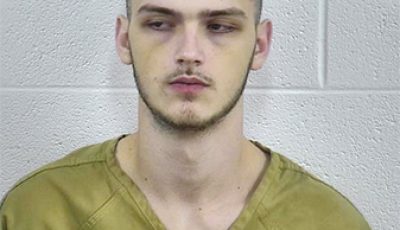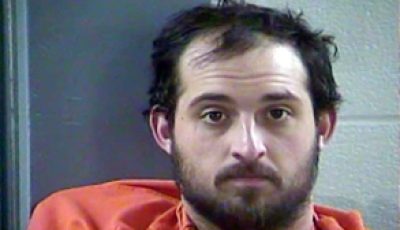Defense claims offer of $40,000 to have four people killed was just ‘jail talk’
Everyone agrees that William Timothy Sutton talked about paying one of his Whitley County Detention Center cellmates $40,000 last year to kill four people.

William Sutton is accused of trying to hire someone to kill four people, including two prosecutors.
Tara Smith and Stephanie Broyles are two women that Sutton used to be involved with, who are now witnesses in cases against him. The other two would-be victims were Whitley County Attorney Bob Hammons and Commonwealth’s Attorney Allen Trimble, who both had prosecuted Sutton.
Everyone agrees that Sutton provided directions to the victims’ homes and what types of vehicles they drove. He provided a description of one of the prosecutors. He also agreed to provide a high-powered rifle for the would-be hit man to use for killing the two prosecutors.
“That conversation took place. No dispute,” defense attorney Willis Coffey told the seven-man, seven-woman U.S. District Court jury during opening statements at Sutton’s murder for hire trial Wednesday morning.
In order for his client to be guilty of four counts of murder for hire though, Sutton would have had to intend for the four people to die, which wasn’t the case, Coffey contended.
“He did not intend to have anyone killed,” Coffey told jurors noting the conversation was just “jail talk” by some inmates, including one, who was trying to get out of his own legal troubles by setting up Sutton for the police.
There was also no way Sutton and his wife could have raised that kind of money, Coffey told jurors adding, “hit men don’t work on credit. It was just talk.”
One of the reasons Sutton’s lawyer probably doesn’t dispute that the conversation took place is the fact that it was recorded by one of Sutton’s cellmates, John Combs, who was wired up twice by Kentucky State Police Trooper David Lassiter, who investigated the case.
In addition to Sutton’s own words, police also recovered a letter that Sutton sent to his brother from jail directing the brother to provide a man named “Jack” with a rifle that Sutton had hidden in a back room of the family business.
Jack was the fake name Combs was supposed to use when picking up the gun, according to the recording.
In the letter Sutton also instructs his brother to wipe his fingerprints from not only the firearm but also the ammunition for it.
Police recovered the weapon where the letter indicated it would be found along with several other firearms.
In addition to standing trial on the four murder for hire charges, Sutton is also facing a charge of one count of illegally possessing of a firearm.
During his opening statement Wednesday, Assistant U.S. Attorney Samuel Dotson told jurors that while in jail, Sutton concocted a scheme to have the four people killed, who he felt were most responsible for him being in jail.
Dotson conceded that the case is “like something out of a Jerry Springer episode,” with the married Sutton having not one, but two mistresses and the baggage that goes along with that.
Dotson also conceded that there was plenty of bad behavior to go around between Sutton and the two female victims, but “they have done nothing to justify their murder.”
He also didn’t dispute that the defense would have plenty of ammunition to attack the credibility of witness John Combs, who was Sutton’s cellmate, and the man, who wore a wire for police on two different occasions.
When you go out to hire a hit man, you don’t go get a teacher or preacher to do it, but rather a criminal, Dotson noted.
Dotson said that at first, Combs wasn’t sure Sutton was serious but after a few weeks of conversation, Sutton told his lawyer, Eric Dixon, about the conversations.
Dixon in turn contacted Hammons, who asked Lassiter to investigate in early March 2017.
On March 3, Lassiter fitted Combs with a wire he wore in the cell with Sutton.
Sutton was spooked by the fact that the other inmates had been taken out of the cell and repeatedly noted that “I got a bad feeling I am being set up for something,” or other words to that effect.
During the second recording on March 6, which is over an hour long, Sutton can be heard telling Combs that the IRS is attacking his mother.
“It’s Tara and Stephanie. They are the ones sicking the IRS,” Sutton said.
During the second recording, Sutton can first be heard giving Combs directions to Broyles home in Knox County, and then to Smith’s home. He includes descriptions of the homes and the type of vehicle each woman has.
Combs asked Sutton if he still wanted him to burn Smith’s body if her child or children were there, which was liable to be the case, because it might set the house on fire.
“If the children aren’t there, burn the body. If they are, just shoot her,” Sutton can be heard saying.
Sutton then gives Combs directions to Hammons home and a description of him before finally passing on directions to Trimble’s home. No description is given of Trimble because it was felt everyone knows what he looks like, the two men said during the recorded conversation.
Sutton can be heard offering tips on what vehicles the two men drive, and noting that they return home from work about the same time.
“Nothing elaborate with them, just shoot them?” Combs asked.
“Yeah,” Sutton replied.
Sutton can be heard telling Combs that Broyles and Smith were the priorities.
“I don’t care if it takes two or three years,” with Hammons and Trimble, Sutton told Combs.
Sutton tells Combs that his brother is going to clean up a .308 rifle that he is supplying for the Hammons and Trimble killings.
“You could snipe from 1,000 yards with a .308,” Sutton noted. “With the scope and site, no problem 1,000 yards.”
During the conversation, Combs confirms that after he kills Smith and Broyles, he is supposed to take a picture of their dead bodies to show Sutton, and then erase the pictures from his phone or destroy it.
“Don’t worry, I will take that rifle, cut it up and through it away,” Combs tells Sutton.
Multiple times during the recording, Combs can be heard noting that once this is done, it cannot be undone.
“Once I do this, there is no undoing it,” Combs said.
“I know,” Sutton replied.
Combs then asked if Sutton could live with that, and he replies that he can.
“You have no idea what this b! #$# Has done to me,” Sutton tells Combs at one point, but it is unclear which woman he is referring too.
Willis took issue with the fact that Combs first-degree trafficking in a controlled substance charge was dismissed as a result of his cooperation with police. He also got out of jail days after cooperating with police and received $400 from the ATF.
During earlier testimony Wednesday, Lassiter testified about an earlier possible murder plot in 2016 that he helped investigate that Sutton reported to police.
Sutton told police that a man named Will Rogers approached him about killing Smith, whom Sutton fathered a child with.
Rogers denied approaching Sutton offering to kill Smith, and said Sutton was the one offering him money to do it.
Sutton denied the allegation during an interview with police, and Trimble ultimately decided there wasn’t enough evidence to proceed with charges against anyone.
During Sutton’s recorded 2016 interview with police that was played for the jury, he mentions paying a lawyer $22,500 to prove his innocence in another case.
Sutton’s trial is expected to conclude Monday in U.S. District Court in London.








